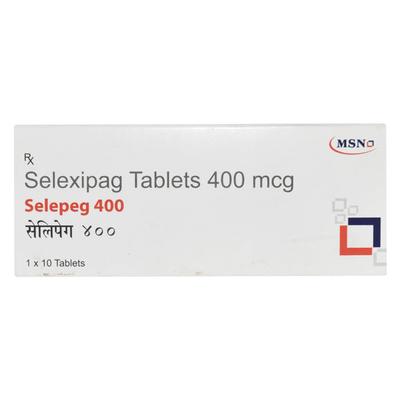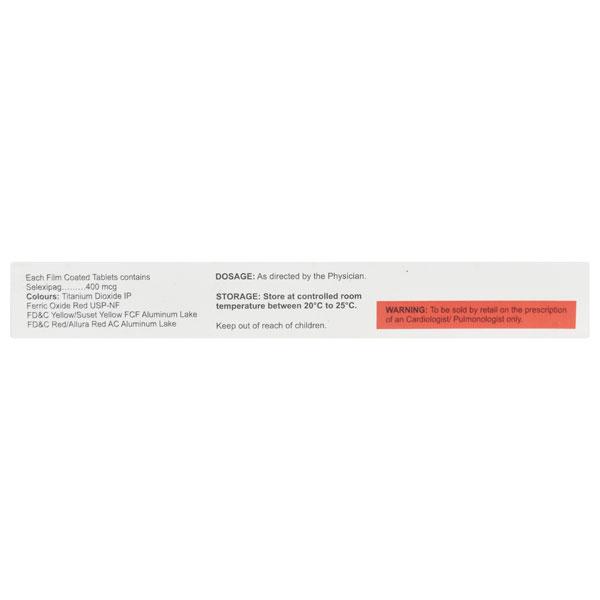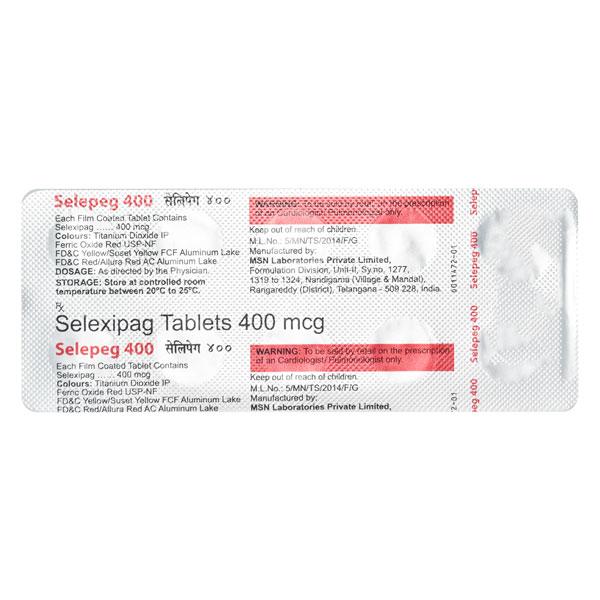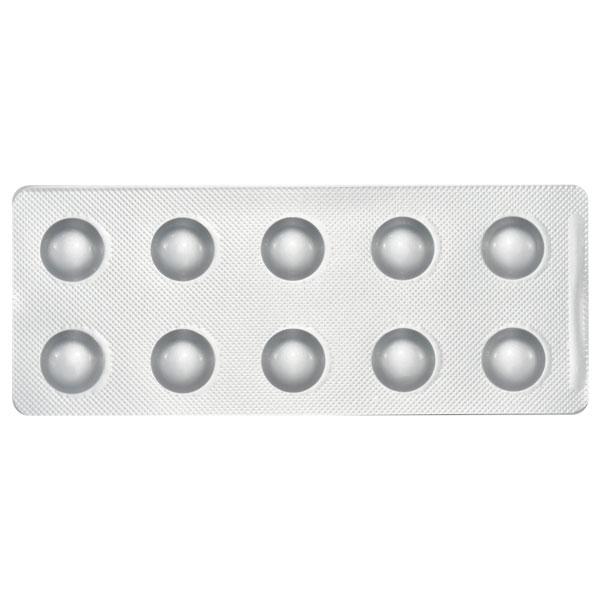

Netmeds First Membership
Quick Links
Introduction About SELEPEG 400 TABLET
SELEPEG 400 TABLET contains Selexipag, which belongs to the group of medicines known as Prostacyclin Receptor Agonists. It is used for the long-term management of Pulmonary Arterial Hypertension (PAH - a condition with increased pressure due to the narrowing of blood vessels supplying the lungs from the heart lungs) in adults. The symptoms of PAH may include dizziness, tiredness, shortness of breath, swelling in the ankles and legs, chest pain, heart failure, etc.
SELEPEG 400 TABLET is not recommended for use in patients with coronary heart disease (poor blood supply to heart muscles, unstable angina (chest pain), weak heart (decompensated heart failure), a history of heart attack within the past 6 months, congenital or acquired heart valve disease, severe arrhythmias (irregular heartbeat).
SELEPEG 400 TABLET should be taken with caution in patients with narrowing of the pulmonary vein, a condition called pulmonary venous-occlusive disease, severe liver disease, severe kidney disease, low blood pressure (hypotension) with dizziness and hyperthyroidism.
SELEPEG 400 TABLET is generally not recommended for use by pregnant women, breastfeeding mothers and children less than 18 years of age. SELEPEG 400 TABLET is also not recommended for use in children under the age of 18 years. SELEPEG 400 TABLET should be used with caution in patients above 75 years of age.
The side effects of taking SELEPEG 400 TABLET may include headache, flushing (reddening of the face), nausea, vomiting, diarrhoea, jaw pain, muscle pain, joint pain, nasopharyngitis (stuffy nose), anaemia, weight loss, rashes, stomach pain, hypotension (low blood pressure), hyperthyroidism, tachycardia (increased heart rate), etc. Consult your doctor if any of the side effects get worse.
Uses Of SELEPEG 400 TABLET
- Manage Pulmonary arterial hypertension (PAH)
How SELEPEG 400 TABLET Works
SELEPEG 400 TABLET works similarly to a natural substance present in our body (Prostacyclin) by widening the pulmonary arteries and reducing their hardness. Doing so makes it easier for the heart to pump blood to the lungs effectively. It also decreases pressure in pulmonary arteries, hence reducing the symptoms of pulmonary arterial hypertension and slowing down the progression of the disease. The metabolite released by SELEPEG 400 TABLET has vasodilatory, anti-proliferative and anti-fibrotic effects.
How to use SELEPEG 400 TABLET
Take SELEPEG 400 TABLET as advised by your physician. Swallow the medicine with a glass of water and do not crush or chew the medicine. Your management dose and duration will be decided by your physician depending on your age, body weight and disease condition.
Side Effects Of SELEPEG 400 TABLET
Common
- headache
- flushing (reddening of the face)
- nausea and vomiting, diarrhoea
- jaw pain, pain in muscles and joints
- leg pain
- nasopharyngitis (stuffy nose)
- anaemia (low red blood cell levels)
- hyperthyroidism (overactive thyroid gland)
- reduced appetite
- weight loss
- hypotension (low blood pressure)
- stomach pain
- affects the blood test results, including the blood cell counts or thyroid function test
- rashes and hives may cause a burning or stinging sensation and skin redness
Uncommon
- tachycardia (increased heart rate)
How To Manage Side Effects
Headache:
Rest and relax. Apply a pain-relieving balm to your forehead if needed. Contact your doctor if the headache persists.
Nausea, vomiting:
Take the medicine, with or just after a meal. Stick to simple meals. Avoid eating oily or spicy foods. Contact your doctor if your symptom gets worse or persist.
Stomach pain:
Try to rest and relax. Eat small meals but take them frequently. Keep a heating pad on your stomach. Contact your doctor if your symptom gets worse or persist.
Diarrhoea:
Drink plenty of water or fruit juice to keep you hydrated. Do not take any medication on your own to manage diarrhoea. Contact your doctor if your symptom gets worse or persist.
Itchy skin:
Avoid hot showers because hot water can irritate the skin. Do not scratch the affected area. Use sunscreen and protective clothing when outdoors. Use moisturizers to soothe and hydrate the affected skin area. Contact your doctor if your symptom gets worse or persist.
Warning & Precautions
Pregnancy
SELEPEG 400 TABLET is generally not recommended for use in pregnant women. Consult your doctor before taking it.
Breastfeeding
SELEPEG 400 TABLET is generally not recommended for use in breastfeeding women as it is not known whether it may pass through the breast milk. Consult your doctor before taking it.
Driving and Using Machines
SELEPEG 400 TABLET causes headaches and low blood pressure, which can affect your ability to drive and operate machines. Consult your doctor for advice.
Kidney
SELEPEG 400 TABLET should be taken with caution in patients with severe kidney disease. Consult your doctor before taking SELEPEG 400 TABLET.
Liver
SELEPEG 400 TABLET should be used with caution in patients with severe liver disease. Consult your doctor before taking SELEPEG 400 TABLET.
Allergy
Do not take SELEPEG 400 TABLET if you are allergic to selexipag or other ingredients in this medicine.
Lungs
SELEPEG 400 TABLET should be taken with caution in patients with lung diseases such as narrowing of the pulmonary veins, a condition called pulmonary venous-occlusive disease. Consult your doctor before taking SELEPEG 400 TABLET.
Heart Disease
GBNKEYWORD] is not recommended for use in patients with coronary heart disease (poor blood supply to heart muscles) or unstable angina (chest pain), weak heart (decompensated heart failure, a history of heart attack within the past 6 months, congenital or acquired heart valve disease, severe arrhythmias (irregular heartbeat). It should be used with caution in patients suffering from hypotension (low blood pressure). Consult your doctor before taking SELEPEG 400 TABLET.
Others
SELEPEG 400 TABLET is not indicated for use if you:
- have suffered a stroke within the past 3 months
- have a transient ischemic stroke
Before taking SELEPEG 400 TABLET, inform your doctor if you:
- have a hyperactive thyroid gland
- have recently suffered from severe diarrhoea or vomiting or significant blood loss
Use in paediatrics:
SELEPEG 400 TABLET is generally not recommended for use in children and adolescents (under 18 years of age). Consult your doctor before taking it.
Use in geriatrics:
SELEPEG 400 TABLET should be used with caution in elderly patients (aged above 75 years). Consult your doctor before taking it.
Interactions
A. Drug-Drug interactions:
Before taking SELEPEG 400 TABLET, inform your physician if you are taking any of the following medicine:
- gemfibrozil (a medicine used to lower the level of fats in the blood)
- clopidogrel (a medicine used for managing blood clots)
- deferasirox (a medicine used to manage iron overload)
- carbamazepine (a medicine used in the management of fits & seizures, nerve pain or to help control serious mood disorders when some other medicines do not work)
- teriflunomide (a medicine used for relapsing-remitting multiple sclerosis)
- phenytoin, valproic acid (a medicine used for the management of fits & seizures)
- probenecid (a medicine used in the management of gout)
- fluconazole (a medicine used for the management of fungal infections)
- rifampicin or rifapentine (a medicine used for the management of tuberculosis)
- lopinavir, ritonavir (medicines used for the management of HIV infections)
Overdosage:
If you or anyone else have accidentally taken too much of SELEPEG 400 TABLET, consult your doctor immediately or visit the nearby hospital. Symptoms of overdose are mild transient nausea
Synopsis
| Drug | : | Selexipag |
| Pharmacological Category | : | Prostacyclin Receptor Agonist |
| Therapeutic Indication | : | Manages Pulmonary arterial hypertension (PAH) |
| Dosage Forms | : | Tablet |
More Information
- Keep SELEPEG 400 TABLET out of reach from children
- Store at room temperature
FAQs About SELEPEG 400 TABLET
What is pulmonary hypertension?
Pulmonary arterial hypertension (PAH) is a condition in which the blood vessels that carry blood from the heart to the lungs become narrow, leading to increased pressure in the blood vessels. The symptoms of pulmonary arterial hypertension (PAH) include dizziness, tiredness, shortness of breath, chest pain and swelling in the ankles and legs. Prolonged pulmonary hypertension may also lead to serious conditions such as right heart failure.
Does SELEPEG 400 TABLET cause hypotension?
Yes, SELEPEG 400 TABLET causes hypotension (low blood pressure). Do not drive or operate any machines if you feel dizzy after taking SELEPEG 400 TABLET.
How does SELEPEG 400 TABLET work?
SELEPEG 400 TABLET works by widening the pulmonary arteries & reducing their hardness. Thus, it is easier for the heart to pump and supply blood to the lungs effectively. It also decreases pressure in pulmonary arteries hence reducing the symptoms of pulmonary arterial hypertension & slowing down the progression of the disease.
Is SELEPEG 400 TABLET safe for heart patients?
SELEPEG 400 TABLET is not recommended for use in patients suffering from coronary heart disease (poor blood supply to heart muscles), a history of heart attack within the past 6 months, congenital or acquired heart valve disease, severe arrhythmias (irregular heartbeat) & and should be used with caution in patients suffering from hypotension (low blood pressure). Consult your doctor before taking SELEPEG 400 TABLET.
Can I operate machinery or drive after consuming SELEPEG 400 TABLET?
SELEPEG 400 TABLET causes headaches and low blood pressure, which can affect your ability to drive and operate machines. Do not drive or operate any machinery after taking SELEPEG 400 TABLET.
What are the side effects of SELEPEG 400 TABLET?
Patients taking SELEPEG 400 TABLET may experience side effects such as headache, flushing (reddening of the face), nausea, vomiting, diarrhoea, jaw pain, muscle pain, joint pain, nasopharyngitis (stuffy nose), anaemia, weight loss, rashes, stomach pain, hypotension (low blood pressure), hyperthyroidism, tachycardia (increased heart rate). Consult your doctor if any of the side effects worsen.
Is SELEPEG 400 TABLET a prostacyclin?
Yes, SELEPEG 400 TABLET is an oral selective prostacyclin receptor agonist. It is used for the long-term management of pulmonary arterial hypertension (a condition in which blood vessels that carry blood from the heart to the lungs become narrow, leading to increased pressure in blood vessels) in adults.
References
1. Onur yazici, hasan gungor. Selexipag: a new treatment agent for pulmonary hypertension. Meandros medical & dental journal 2029-2020. [Accessed on 12th August 2022] https://cms.galenos.com.tr/Uploads/Article_27391/MMDJ-20-1-En.pdf
2. Janssen pharmaceutica NV. Electronic Medicines Compendium (EMC). [Revised in March 2021] [Accessed 12th August 2022] https://www.medicines.org.uk/emc/files/pil.2163.pdf
3. Actelion Pharmaceutical US. U.S. Food & Drug Administration. [Revised in December 2015] [Accessed 12th August 2022] https://www.accessdata.fda.gov/drugsatfda_docs/label/2015/207947s000lbl.pdf
4. Janssen Pharmaceutica NV. European medicine agency. [Revised in December 2020] [Accessed on 12th August 2022] https://www.ema.europa.eu/en/documents/product-information/uptravi-epar-product-information_en.pdf
5. Actelion Pharmaceuticals Ltd. Selexipag. [Revised in August 2017] [Accessed 12th August 2022] https://pdf.hres.ca/dpd_pm/00040713.PDF
Useful Diagnostic Tests
- Echocardiogram
- Comprehensive metabolic panel
- Thyroid function tests
- B-type Natriuretic Peptide
- Chest X-ray
- Pulmonary function test














